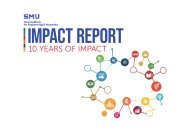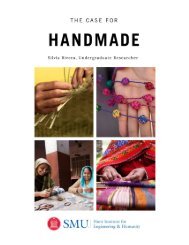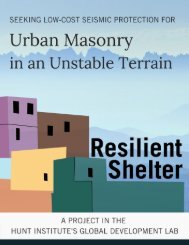Bridging the Gap in Diagnostics
Traditionally, biomedical engineers have developed technologies in response to the needs of the developed world’s medical community. These approaches often do not address the needs of the majority of the world’s peoples afflicted with both communicable and non-communicable diseases as the developments are far too costly and those with most need have, at best, limited access to supporting clinical laboratory infrastructure in developing countries. A gap in care has emerged as a result of these conditions. As a result, Drs. Beskok and Koklu have developed a Lab on a Chip technology that can test for a chosen disease with a turnaround time of just a few seconds and a detection limit of 1 ng of antigen per 1 mL of sample fluid. This is a great improvement to current devices on the market and is particularly useful in high-throughput, low-skill staffing environments. This report researched and authored by an interdisciplinary group of undergraduate students at the Southern Methodist University working in the Hunt Institute aims to address the areas of greatest need in response to UNSDG #3 "to ensure healthy lives and promote wellbeing for all at all ages."
Traditionally, biomedical engineers have developed technologies in response to the needs of the developed world’s medical community. These approaches often do not address the needs of the majority of the world’s peoples afflicted with both communicable and non-communicable diseases as the developments are far too costly and those with most need have, at best, limited access to supporting clinical laboratory infrastructure in developing countries. A gap in care has emerged as a result of these conditions. As a result, Drs. Beskok and Koklu have developed a Lab on a Chip technology that can test for a chosen disease with a turnaround time of just a few seconds and a detection limit of 1 ng of antigen per 1 mL of sample fluid. This is a great improvement to current devices on the market and is particularly useful in high-throughput, low-skill staffing environments. This report researched and authored by an interdisciplinary group of undergraduate students at the Southern Methodist University working in the Hunt Institute aims to address the areas of greatest need in response to UNSDG #3 "to ensure healthy lives and promote wellbeing for all at all ages."
You also want an ePaper? Increase the reach of your titles
YUMPU automatically turns print PDFs into web optimized ePapers that Google loves.
4.1 TUBERCULOSIS
Based off a WHO report on global and regional Tuberculosis (TB) incidents in Africa
and South-East Asia make up nearly 70% of all incidents world-wide. Annually, more than 95%
of cases and deaths from TB occur within developing countries. Those undernourished are 3
times as likely to contract TB. In addition, 1.1 million children (0–14 years of age) fell ill with
TB, and 230,000 children (including children with HIV associated TB) died from the disease in
2018. 19 While these numbers are striking, the DALY values for TB rank in the top 10 globally
(see Figure 3). 18
Region Global Africa South-East Asia
DALYs
(000s)
% of total
DALYs
DALYs
(000s)
% of total
DALYs
DALYs
(000s)
% of total
DALYs
Tuberculosis 51642.60 1.94 18393.29 3.07 23836.35 3.35
Malaria 37368.77 1.40 34679.77 5.79 1833.92 0.26
Figure 6: 2016 DALY for Global, the African region, and the South-East Asia region as provided by the WHO’s report on
leading causes of death from 2000 to 2016 18
The overall make-up of treatment options for and affected groups by TB make it a great
option for initial deployment of a rapid-diagnosis point of care device. TB continues to have a
significant effect on countries with developing economies and countries in transition, and based
on 2018 published numbers, is off track for the UN Sustainability Goal 3, under which a target is
to end the epidemics of AIDS, TB, malaria and neglected tropical diseases, and combat hepatitis,
water-borne diseases and other communicable diseases. 3
4.1.1 GLOBAL FUNDING FOR TUBERCULOSIS
Based off a report by the Treatment Action Group (TAG) published in December 2018,
global funding for TB has remained steady since 2009, when adjusted for inflation. 20 These
findings prove optimistic for the continued interest in TB research and the Global End TB
campaign.
When funding for TB is broken down into 5 major categories, over the 2016 and 2017
funding periods, research in vaccines and diagnostics still has a wide gap left for the 5-year
period. As funding organizations choose sector-specific funding targets in the coming years -
diagnostics are high on the list with nearly $3.3 billion USD left to fund to meet the 5-year
global funding target (see Figure 4). This monetarily signifies a need for continued development
and deployment in the three areas of diagnostics, drugs, and vaccines.
24













